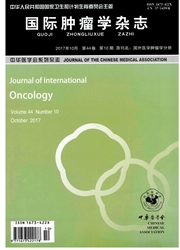

 中文摘要:
中文摘要:
BACKGROUND:Combined hepatocellular carcinoma and cholangiocarcinoma (cHCC-CC) is an uncommon subtype of primary hepatic carcinoma,and its prognosis is poor.This study was undertaken to investigate the prognosis and the clinicopathological characteristics of cHCC-CC,including their possible cellular origin.METHODS:Among 852 patients with a primary hepatic carcinoma who underwent hepatectomy from January 1998 to April 2008 at our hospital,cHCC-CC was identified in 14 patients The clinicopathological characteristics of the 14 patients were analyzed retrospectively.The expression of the liver stem cell markers (c-kit,CD90,CD133 and CK19) in the tumor tissue was detected by immunohistochemistry,and the Kaplan-Meier method was used to evaluate survival.RESULTS:Among the 14 patients,9 presented with abdominal pain,3 with anorexia and debilitation,and the remaining two patients were asymptomatic.The mean age was 53.6±3.0 (range 38-74) years.Among the included patients,11 had an elevated serum alpha-fetoprotein level,13 were infected with hepatitis B virus,9 had vascular invasion and 1 had lymph node metastasis The average diameter of the tumors was 9.9±1.1 (range 5.0-16.0) cm.The median overall survival time was 7.9±1.0 months In addition,the presence of the liver stem cell markers,c-kit CD90,CD133 and CK19 was 71.4%,85.7%,92.9% and 78.6% respectively.All four markers were simultaneously expressed in eight cases.CONCLUSIONS:cHCC-CC has aggressive characteristics and the prognosis is extremely dismal.The high expression of liver stem cell markers in the tumor tissue suggests that these tumors may derive from liver stem cells.
 同期刊论文项目
同期刊论文项目
 同项目期刊论文
同项目期刊论文
 Prognostic Factors and Outcome of 438 Chinese Patients with Hepatocellular Carcinoma Underwent Parti
Prognostic Factors and Outcome of 438 Chinese Patients with Hepatocellular Carcinoma Underwent Parti Clinical and pathological analysis of hepatic artery aneurysm in a patient with systemic lupus eryth
Clinical and pathological analysis of hepatic artery aneurysm in a patient with systemic lupus eryth Clinicopathological analysis of 14 patients with combined hepatocellular carcinoma and cholangiocarc
Clinicopathological analysis of 14 patients with combined hepatocellular carcinoma and cholangiocarc 期刊信息
期刊信息
